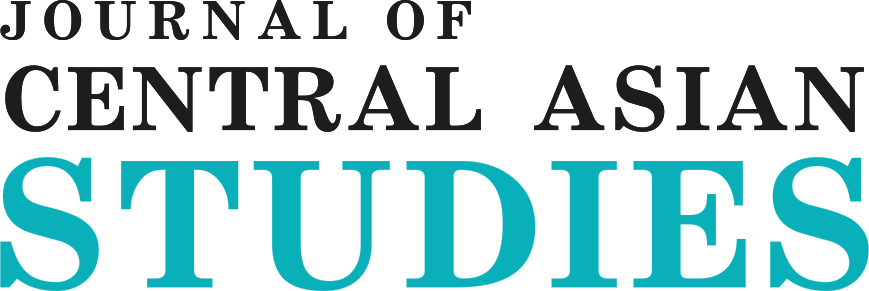Bibliometric Analysis of Thematic Networks in Central Asian Integration Literature: Trends, Clusters, and Emerging Research Directions
DOI:
https://doi.org/10.52536/3006-807X.2025-1.006Keywords:
Central Asia, integration, regional development, economic integration, bibliometric analysis, network analysisAbstract
In this article, the scientific literature on integration processes in Central Asia was studied using the method of bibliometric analysis from the point of view of thematic networks. The purpose of the study is to identify the main directions of works covering the problems of integration, to show trends in their development, and to establish new prospects for future research. In the course of the analysis, three main clusters of scientific literature were identified: economic integration, regional development, and water resources management. In addition, new research areas related to economic development, environmental issues, and transport and logistics infrastructure have been identified. The results of the study show the main challenges and new opportunities for cooperation in the region and emphasize the need for a comprehensive consideration of integration processes. This article can serve as a methodological basis for scientific papers devoted to the study of integration ties in Central Asia in the future.
References
Aria, M., & Cuccurullo, C. (2017). Bibliometrix: An R-tool for comprehensive science mapping analysis. Journal of Informetrics, 11(4), 959-975. https://doi.org/10.1016/j.joi.2017.08.007
Ateed, E., & Özcan, M. (2023). A Critical Analysis on the Impediments of Regional Integration in Central Asia. RUDN Journal of World History. https://doi.org/10.22363/2312-8127-2023-15-2-137-157.
CAA Network. (2021). Episode 4 with Sanat Kushkumbaev and Timur Kozyrev: Turkic Union or Union of Central Asian Countries? Retrieved from https://www.caa-network.org/archives/22435/epizod-4-s-sanatom-kushkumbaevym-i-timurom-kozyrevym-tyurkskij-soyuz-ili-soyuz-stran-czentralnoj-azii
Cantori, L. J., & Spiegel, S. L. (1969). International Regions: A Comparative Approach to Five Subordinate Systems. International Studies Quarterly, 13(4), 361–380. https://doi.org/10.2307/3013600
Cao, H. (2024). Integration Process in Central Asia: The Interaction of Nationalism and Regionalism. Journal of Politics and Law. 17. 38. 10.5539/jpl.v17n3p38.
Central Asia Barometer. (2022). A more integrated future: Mapping Central Asian optimism. Retrieved from https://ca-barometer.org/en/publications/a-more-integrated-future-mapping-central-asian-optimism
Costa Buranelli, F. (2021). Central Asian Regionalism or Central Asian Order? Some Reflections. Central Asian Affairs, 8(1), 1-26. https://doi.org/10.30965/22142290-bja10015
Delovarova L., Sultanmuratov N., & Yermekbayev A. (2023). Some theoretical and practical aspects of regional integration in Central Asia. assessment of economic potential. Central Asia's affairs, 89(1):32-41. doi: 10.52536/2788-5909.2023-1.03
Donthu, N., Kumar, S., Mukherjee, D., Pandey, N., & Lim, W. M. (2021). How to conduct a bibliometric analysis: An overview and guidelines. Journal of Business Research, 133, 285-296. https://doi.org/10.1016/j.jbusres.2021.04.070
Echchakoui, S. (2020). Why and how to merge Scopus and Web of Science during bibliometric analysis: The case of sales force literature from 1912 to 2019. Journal of Marketing Analytics, 8, 165-184. https://doi.org/10.1057/s41270-020-00081-9
Gao, S., Meng, F., Gu, Z., Liu, Z., & Farrukh, M. (2021). Mapping and clustering analysis on environmental, social and governance field a bibliometric analysis using Scopus. Sustainability, 13(13), 7304. https://doi.org/10.3390/su13137304
Harzing, A.W., & Alakangas, S. (2016). Google Scholar, Scopus and the Web of Science: A longitudinal and cross-disciplinary comparison. Scientometrics, 106, 787-804. https://doi.org/10.1007/s11192-015-1798-9
Kazakhstan Institute for Strategic Studies under the President of the Republic of Kazakhstan. (2023). Kazakhstan-2023: Trends of the present and outlines of the future. A collective monograph. Astana: Kazakhstan Institute for Strategic Studies under the President of the Republic of Kazakhstan.
Khan, H. M. R., Ahmad, S., Javed, R., & Nasir, N. (2023). The significance of artificial intelligence in business and accounting: A bibliometric analysis. Pakistan Journal of Humanities and Social Sciences, 11(2), 1088-1110. https://doi.org/10.52131/pjhss.2023.1102.0417
Koichumanova, C. (2022). Integration of the Central Asian Countries in Current Stage: Dynamic, Stage, Problems and Perspectives. ISTORIYA.
Kushkumbaev S.K. (2022). Kazakhstan and Central Asia: Between the Challenges of the Past and the Future. A Collection of Articles, Speeches, and Interviews. Astana, 372 pages.
Lee, J., Asiryan, A., & Butler, M. (2020). Integration of the Central Asian Republics: the ASEAN example. EInternational Relations. Retrieved November 8, 2023, from https://www.e-ir.info/2020/09/17/integration-ofthe-central-asian-republics-the-asean-example/
Lodhi, R.N., Del Gesso, C., Asif, M. & Cobanoglu, C. (2024). Exploring virtual and augmented reality in the hospitality industry: a bibliometric analysis. Tourism and Hospitality Management, 30(1), 67-84, https://doi.org/10.20867/thm.30.1.5
Mukasheva, Z.Ye & Akhmedyanova, D.K. (2024). Is there a new round of regionalism in Central Asia? Content analysis of the texts of documents and Presidents’ speeches during the IV consultative meeting in 2022. Bulletin of the L.N. Gumilyov Eurasian National University. Political Science. Regional Studies. Oriental Studies. Turkology Series. 146.8-21.10.32523/2616-6887/2024-146-1-8-21.
Peyrouse, S. (2012). The hydro-energy sector in Central Asia and the role of international organizations. Journal of International Affairs, 65(2), 113-131.
Van Eck, N., & Waltman, L. (2010). Software survey: VOSviewer, a computer program for bibliometric mapping. Scientometrics, 84(2), 523-538. https://doi.org/10.1007/s11192-009-0146-3
Wang, L., Chen, X., Bao, A., Zhang X., Wu M., Hao Y. & He J. (2015). A bibliometric analysis of research on Central Asia during 1990–2014. Scientometrics 105, 1223–1237. https://doi.org/10.1007/s11192-015-1727-y
Zupic, I., & Čater, T. (2015). Bibliometric methods in management and organization. Organizational Research Methods, 18(3), 429-472. https://doi.org/10.1177/1094428114562629
Downloads
Published
Issue
Section
License
Copyright (c) 2025 Yelmagambetova G., Dalelkhan A., Lodhi R.N.

This work is licensed under a Creative Commons Attribution 4.0 International License.











 Open content is licensed under the CC-BY
Open content is licensed under the CC-BY 


